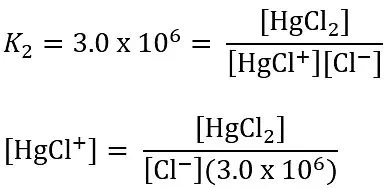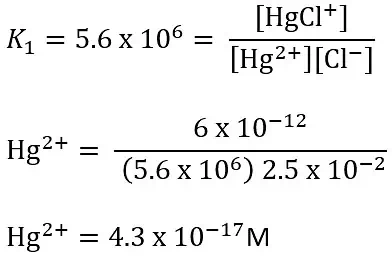In this article (and video above), to help you prepare for the FE exam, we calculate the concentration of a metal compound Hg2+. This problem type may be found in the Chemistry and Biology or Chemical Reactions section of the FE Exam, and was created and solved by Engineer in training, Enrique Ivers, LEED Green Associate.
Question:
The Chloride (Cl–) concentration in a lake is found to be 2.5 x 10-2. The HgCl₂ (aq) concentration is found to be 5 x 10-7M. The following chemical equations and equilibrium constants apply:
The concentration of Hg2+ is most nearly:
Solution:
We’re given the equilibrium constants for both chemical equations, the concentration of HgCl₂ (aq), and the concentration of Cl–.
Starting with the second equation, we can work backwards and solve for the concentration of HgCl+. From there, we can solve for the concentration of Cl–.
We can now substitute the known concentrations:
We can now substitute our known constants into the first chemical equation and solve for the concentration of Hg2+:
Answer:
The correct answer is B.
This Episode Is Brought to You by PPI

I hope you found this week’s FE Environmental engineering exam prep question helpful. In upcoming articles, I will answer more FE Exam questions and run through more practice problems. We publish videos bi-weekly on our Pass the FE Exam YouTube Channel. Be sure to visit our page here and click the subscribe button as you’ll get expert tips and tricks – to ensure your best success – that you can’t get anywhere else. Believe me, you won’t want to miss a single video.
Lastly, I encourage you to ask questions in the comments of the videos or here on this page and I’ll read and respond to them in future videos. So, if there’s a specific topic you want me to cover or answer, we have you covered.
I’ll see you next week.
Anthony Fasano, P.E.
Engineering Management Institute
Author of Engineer Your Own Success






Leave a Reply